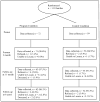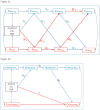Long-term effects of the Family Bereavement Program on spousally bereaved parents: Grief, mental health problems, alcohol problems, and coping efficacy
- PMID: 27427807
- PMCID: PMC5026637
- DOI: 10.1017/S0954579416000328
Long-term effects of the Family Bereavement Program on spousally bereaved parents: Grief, mental health problems, alcohol problems, and coping efficacy
Abstract
This study reports on the findings from a 6-year follow-up of a randomized trial of the Family Bereavement Program (FBP) on the outcomes for spousally bereaved parents. Spousally bereaved parents (N = 131) participated in the trial in which they were randomly assigned to receive the FBP (N = 72) or literature control (N = 59). Parents were assessed at four time points: pretest, posttest, and 11-month and 6-year follow-up. They reported on mental health problems, grief, and parenting at all four time periods. At the 6-year follow-up, parents reported on additional measures of persistent complex bereavement disorder, alcohol abuse problems, and coping efficacy. Bereaved parents in the FBP as compared to those in the literature control had lower levels of symptoms of depression, general psychiatric distress, prolonged grief, and alcohol problems, and higher coping efficacy (for mothers) at the 6-year follow-up. Multiple characteristics of the parent (e.g., gender, age, and baseline mental health problems) and of the spousal death (e.g., cause of death) were tested as moderators of program effects on each outcome, but only 3 of 45 tests of moderation were significant. Latent growth modeling found that the effects of the FBP on depression, psychiatric distress, and grief occurred immediately following program participation and were maintained over 6 years. Mediation analysis found that improvement in positive parenting partially mediated program effects to reduce depression and psychiatric distress, but had an indirect effect to higher levels of grief at the 6-year follow-up. Mediation analysis also found that improved parenting at the 6-year follow-up was partially mediated by program effects to reduce depression and that program effects to increase coping efficacy at the 6-year follow-up was partially mediated through reduced depression and grief and improved parenting. FBP reduced mental health problems, prolonged grief, and alcohol abuse, and increased coping efficacy of spousally bereaved parents 6 years later. Mediation pathways for program effects differed across outcomes at the 6-year follow-up.
Trial registration: ClinicalTrials.gov NCT01008189.
Figures



Similar articles
-
Developmental Pathways of the Family Bereavement Program to Prevent Major Depression 15 Years Later.J Am Acad Child Adolesc Psychiatry. 2023 Nov;62(11):1233-1244. doi: 10.1016/j.jaac.2023.02.012. Epub 2023 Mar 8. J Am Acad Child Adolesc Psychiatry. 2023. PMID: 36898606 Free PMC article. Clinical Trial.
-
Six-year follow-up of a preventive intervention for parentally bereaved youths: a randomized controlled trial.Arch Pediatr Adolesc Med. 2010 Oct;164(10):907-14. doi: 10.1001/archpediatrics.2010.173. Arch Pediatr Adolesc Med. 2010. PMID: 20921347 Free PMC article. Clinical Trial.
-
Strengthening effective parenting practices over the long term: effects of a preventive intervention for parentally bereaved families.J Clin Child Adolesc Psychol. 2012;41(2):177-88. doi: 10.1080/15374416.2012.651996. J Clin Child Adolesc Psychol. 2012. PMID: 22417191 Free PMC article. Clinical Trial.
-
The Phenomenon of Bereaved Parenting: An Integrative Review of Literature.Omega (Westport). 2021 Feb;82(3):424-445. doi: 10.1177/0030222818819350. Epub 2018 Dec 18. Omega (Westport). 2021. PMID: 30563427 Review.
-
When a child dies: a systematic review of well-defined parent-focused bereavement interventions and their alignment with grief- and loss theories.BMC Palliat Care. 2020 Mar 12;19(1):28. doi: 10.1186/s12904-020-0529-z. BMC Palliat Care. 2020. PMID: 32164668 Free PMC article.
Cited by
-
Three perspectives on mental health problems of young adults and their parents at a 15-year follow-up of the family bereavement program.J Consult Clin Psychol. 2018 Oct;86(10):845-855. doi: 10.1037/ccp0000327. J Consult Clin Psychol. 2018. PMID: 30265043 Free PMC article. Clinical Trial.
-
Caregivers' Self-Compassion and Bereaved Children's Adjustment: Testing Caregivers' Mental Health and Parenting as Mediators.Mindfulness (N Y). 2022;13(2):462-473. doi: 10.1007/s12671-021-01807-1. Epub 2022 Jan 9. Mindfulness (N Y). 2022. PMID: 35035597 Free PMC article.
-
Prevalence of alcohol consumption and alcohol use disorders among outdoor drinkers in public open places in Nigeria.BMC Public Health. 2018 Mar 27;18(1):400. doi: 10.1186/s12889-018-5344-6. BMC Public Health. 2018. PMID: 29580226 Free PMC article.
-
On the concept, taxonomy, and transculturality of disordered grief.Front Psychol. 2024 Feb 5;14:1165421. doi: 10.3389/fpsyg.2023.1165421. eCollection 2023. Front Psychol. 2024. PMID: 38374931 Free PMC article. Review.
-
Psychological and parental functioning of widowed fathers: The first two years.J Fam Psychol. 2019 Aug;33(5):565-574. doi: 10.1037/fam0000528. Epub 2019 Apr 25. J Fam Psychol. 2019. PMID: 31021128 Free PMC article.
References
-
- Achenbach TM. Manual for the ASEBA School-age Forms and Profiles. Burlington: Research Center for Children, Youth & Families, University of Vermont; 2001.
-
- Achenbach TM. Manual for the Young Adult Self-report and Young Adult Behavior Checklist. Burlington: Dept. of Psychiatry, University of Vermont; 1997.
-
- Achenbach TM. Data from the CBCL and YABCL. 2003 Unpublished raw data.
-
- American Psychiatric Association. Diagnostic and statistical manual of mental disorders. 5. Arlington, VA: American Psychiatric Publishing; 2013.
-
- Archer J. The nature of grief: The evolution and psychology of reactions to loss. Brunner-Routledge; New York: 1999.
Publication types
MeSH terms
Associated data
Grants and funding
LinkOut - more resources
Full Text Sources
Other Literature Sources
Medical
Miscellaneous

